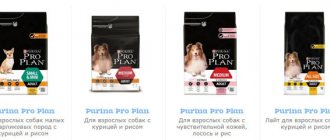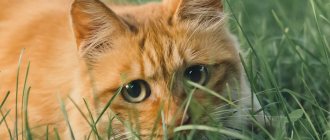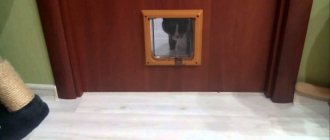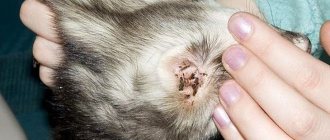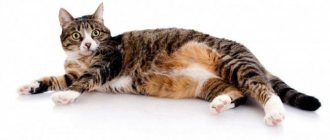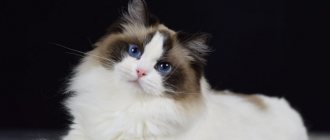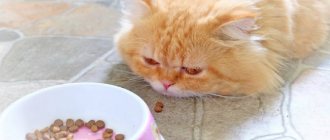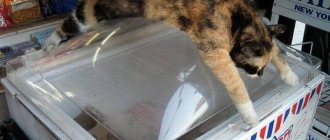Perhaps you will need grass for cats if your pet has ever bitten flowers. The fact is that cats simply need to eat green sprouts, just like people need to eat salads.
If your cat goes outside, you've probably noticed her chewing on different blades of grass from time to time. This is a harmless action - thereby it determines what can be eaten and what is harmful or even dangerous to health. But animals that don't go outside have no way of finding the grass they need. They begin to eat house plants and can harm themselves. Petunias, hydrangeas, lilies, orchids, ficuses and other house plants cause poisoning, swelling and allergies in the animal. Do not punish your pet for damaging your flowers, but offer him healthy grass for cats that you can grow yourself, decorating your apartment and making your pet happy.
Why do cats eat grass?
While walking with your pet, or even in your apartment, you can watch your cat eat grass or your indoor plants. When asked why they do this, there are several versions. So let's look at everything in order:
- Stomach cleansing
Cats are one of the cleanest animals. They can sit and lick their fur for hours. But have we ever thought about what such cleanliness can lead to? A huge amount of hair gets into the pet’s stomach, which in turn is not digested.
Wool that gets into the body leads to problems in the cat’s body.
All fur that enters the body becomes clumps. This is exactly what can pose a serious threat to a cat’s health. And if street cats can cope with this situation by simply chewing hard blades of grass, then a domestic pet cannot cope with the problem on its own. This is where you need to include healthy grass in your pet’s diet. After taking cat grass, the animal’s gag reflex will work, this will normalize intestinal function and allow food to be better absorbed by the body.
- Treatment
When treating a pet, you can use not only traditional means (tablets, injections), but also unconventional methods. This is where grass can help. However, not all herbs have positive properties. It is important to know which herb can help your pet. For example, calendula or goldenseal will help in the treatment of infectious diseases. Red clover and parsley help combat the development of tumors. And herbs such as caraway or nettle cope with stomach upsets and loss of appetite in your pet. And this is just a small list of useful herbs.
Medicinal herb
The components included in the plants will help saturate the tissues with oxygen. Therefore, it is extremely important to give weed to kittens and pregnant cats.
Important! Before starting herbal treatment, you should consult your veterinarian
- Essential vitamins and amino acids
Another reason to give cats grass is for vitamins. Herbs contain and saturate the body with vitamins that are not supplied in the required quantities with food. For example, vitamins B, D, folic acid, as well as minerals and active ingredients.
Useful tips
- If your animal constantly chews grass, often and for a long time, be sure to consult a veterinarian, since this is the first sign of a deficiency of some elements in the body, and can also be a consequence of problems with the digestive tract.
- Cats and cats do not distinguish between beneficial and harmful varieties of herbs. In order not to harm the animal, protect it from such “hot spots” in advance.
- Under no circumstances should you allow your pet to eat green weed or wheatgrass picked from the street. It grows everywhere, and on its blades of grass it can have dangerous worm eggs, dust, viruses and bacteria.
- Before buying another indoor plant, study the beneficial and harmful properties. After all, this caution may cost the life of your pet.
- Grass that is grown at home, without soil, is considered “disposable”. Therefore, plant it in small quantities.
What grass do cats like?
So what kind of grass do our cats still love... Let's look at it in order:
Wheatgrass and licorice
Wheatgrass and licorice root are beneficial not only for people, but also for animals. Licorice helps with allergies, digestive problems, and also for the mucous membrane. But wheatgrass is rich in vitamins A, E, B and microelements that can remove toxins, mucus and hair from the pet’s stomach.
Wheatgrass - to improve cat digestion
Thyme
This herb acts like mint on cats and is completely safe for your pet. Its pleasant aroma attracts the animal, but its effect is slightly stronger than catnip. Thyme is calming and uplifting. The only disadvantage of this plant is that it grows slowly. Therefore, if you want to pamper your pet with this herb, you should plant it in advance and preferably in several pots at once.
Thyme for your pet's calm
Lemongrass or Schisandra, lemongrass
Lemongrass not only smells good. Schisandra has many advantages over other herbs and cats love it very much. Lemograss acts as an antiseptic, antibiotic, and diuretic. And also as a sedative. It can be grown not only on the plot, but also on the windowsill.
Lemongrass is the best antiseptic
Chamomile and calendula
Not only tablets can treat infections and digestive problems. Calendula and chamomile are excellent herbs that can help your pet.
Their decoctions are often used to treat itching, irritation and allergic reactions. And most importantly for the treatment of fungal and infectious diseases. One of the benefits of chamomile is its ability to neutralize the harmful effects of parasites on the intestinal mucosa. Chamomile is also prescribed against worms in pets.
Chamomile against infections
Wheat and oats
Oats are useful because this cereal is rich in nutrients and vitamins. It is able to cleanse the cat's stomach of fur. Due to the fact that oat grass contains folic acid and vitamin B9, it promotes animal growth and increases the amount of oxygen in the blood.
Sprouted wheat grains have a positive effect and act as a laxative. The herb not only helps get rid of hair in the intestines, but also removes undigested foods and small foreign objects.
The most common grass for cats is oats and wheat germ.
Every owner has probably noticed more than once that their beloved pet begins to chew on their favorite indoor plants and seedlings. Some have noticed that if a cat needs a laxative effect, he chooses grass with thin stems, and to strengthen it, eats with a wide stem.
So which grass should your cat choose? First of all, we must not forget that cats are capable of eating even grass that poses a danger to them.
It is generally accepted that all cats love valerian and mint. The only thing your pet likes about these plants is the smell. They usually eat completely different grass. Green oats, wheat and barley are best for sprouting at home. And if you don’t know what will suit your pet, then it’s best to try a mixture of these grains. Your cat will choose which grass she needs.
Not all grass is good for cats
Wheat contains vitamin E, riboflavin, niacin, manganese, zinc, vitamin B6, pantothenic acid. Oats are useful for vitamins A, D, folic acid, vitamin B9.
IMPORTANT! The height of sprouted oats and wheat should not exceed 30 cm, as toxins accumulate at the tips
Poisonous bulbous crops
Often, cat owners do not even suspect that innocent play with a flower or onions added to their pet's food can have a poisonous effect. Therefore, we settled on bulbous plants separately.
- Onion and garlic. Due to the high content of disulfides, which give such a specific aroma, they are extremely dangerous for cats. These compounds cause oxygen deficiency because they destroy red blood cells - red blood cells, whose function is to transport oxygen molecules, including to the brain.
- Liliaceae. When consuming even a small portion of some types of lilies, cats are highly likely to experience severe acute kidney failure, often irreversible. Tiger lilies, Asiatic lilies, Japanese lilies and Easter lilies are very toxic. Pollen from any of these lilies is deadly poisonous to cats. Licking pollen from fur can be fatal.
- Narcissus. The bulb is the most toxic part of the plant. Ingestion of any part of the daffodil may cause vomiting, diarrhea, abdominal pain, arrhythmia (irregular heart rhythm), seizures, and low blood pressure.
- Autumn crocus. May cause vomiting, diarrhea, seizures, liver and kidney damage, and arrhythmias in cats. The whole plant is poisonous, but the highest toxicity is in the bulbs.
- Tulip. Ingestion may cause oral irritation, increased drooling and nausea.
- May lily of the valley. When eating the fruit, vomiting, diarrhea, and heart problems occur. Blood pressure drops sharply and consciousness becomes clouded. Both flowers and bulbs are poisonous to cats.
- Snowdrop. All parts of our favorite spring flowers are completely poisonous to cats. They cause disruption of the gastrointestinal tract, allergies, heart failure and even cardiac arrest.
Care should be taken to ensure that cats cannot drink the water in which these flowers stand. The water is also poisonous, and the animal can be poisoned!
It is recommended to use stable vases with a narrow neck and place them out of reach of a curious “tail”.
Which seeds to choose
As has already become known, not every grass is suitable for planting. It is best to choose the seeds of oats, wheat, barley and other cereal plants at the pet store. And if you are not sure that this particular herb will help your pet, choose complex preparations, because the market does not stand still and is constantly evolving.
Different cats eat different grass
And yet, what is the best grass to plant for a cat at home? Now we will look at several options that pet stores offer us:
| Name | Compound | Growing methods |
| Alpine meadows 7 herbs | Oats, wheat, rye, barley, millet, sorghum, vetch; | Herbs in a vermiculite-based substrate. The kit comes with a container, pour out the substance, moisten it with water, lay out the seeds, cover the container with a lid. Place in a warm, bright place. The grass grows in approximately 10 days. |
| Horse | Oats, ryegrass, meadow grass; | Seeds can be germinated in any way convenient for you. Approximate growing time is one and a half to two weeks. Grass height 10 cm. |
| Weed for cats TitBit | Oats | This product is very easy to use, as it comes with a container and a padding polyester bag. You just need to pour water on it, cover it with a lid and place it in a warm, lighted place. After 8-10 days, your cat can enjoy fresh grass. |
cat's paw
Cat's paw gets its name from its soft, fluffy inflorescences, and cats are completely indifferent to it. But this plant is very useful for humans. With its help, they stop bleeding and diarrhea, treat tuberculosis, bronchitis, the digestive system, liver and gall bladder. The plant is found in pine forests, clearings and meadows, but it can also be grown in a garden bed. Cat's paw seeds are small, growing from them is a thankless task, especially since this perennial easily propagates vegetatively: by dividing the bush, layering, and cuttings. Cat's paw prefers light sandy soils, sunny places, and good drainage. The plant does not need fertilizer.
Growing methods
The grass can be found in ready-made form at a pet store, or you can simply pick it on the street. But if you still decide to sow and grow a tasty and healthy treat for your pet yourself, then let’s look at several planting options.
Option #1
Planting grass in soil or vermiculite.
This method is perfect for those who have large space on window sills and balconies. To begin with, you will need an oblong container for soil, or an ordinary pot. You can buy ready-made soil at a pet store or veterinary store, the main thing is to make sure that it is not oversaturated with various additives and minerals. The pot for germinating grain crops must have a drainage system (small holes at the bottom of the container). This will ensure oxygen saturation. To drain excess moisture, a stand is needed.
Landing algorithm:
- Soak the seeds in water for 40-60 minutes;
- Fill the container with soil to about halfway;
- Water the soil thoroughly;
- Place the soaked seeds so that they cover the entire space. This will ensure a dense harvest, even if some sprouted seeds do not sprout;
- Cover the seeds with 0.5-1 cm of soil;
- Be sure to cover the ground with cling film or polyethylene. This will provide a greenhouse effect and help the seeds germinate faster.
- As soon as the first shoots appear 2-3 cm from the ground, you can remove the film;
- Growing time is 10-15 days.
Germinating seeds in the ground
Option No. 2
Growing grass without soil.
The method of growing grass in an artificial environment without soil is called hydroponics. This planting option is very convenient for use at home - it will protect you from soil scattered around the apartment.
In this method, we also need a container for planting, as well as gauze, cotton wool, and polyethylene.
Landing algorithm:
- Take a container, cover the bottom with cotton wool, approximately 3-5 cm;
- Water the cotton wool generously;
- Cover the top with gauze; if there is no gauze, you can use a bandage:
- Pour the grains in random order;
- Cover the seed with film;
- Do not open the film at first so that moisture does not evaporate;
- The first white sprouts will appear on the 5th day; during this period you can sometimes remove the film to water the sprouts;
- We finally remove the film when the green sprouts are 2-3 cm from the ground.
Germinating seeds in cotton wool and gauze
Price
You can purchase useful vegetation for cats at any pet store.
Prices depend on whether the grass is sprouted or not, and whether there is a special container included in the supplement:
- Seeds of oats or wheat, simple, not grown, cost between 20-30 rubles.
- A set of seeds, soils, not grown, have a price of up to 50 rubles.
- A sprouted set with seeds, pots and instructions costs up to 150 rubles.
Considering that the seeds germinate quite quickly, you can, in the absence of sprouted ones, or to save money, purchase regular grains in a bag.

